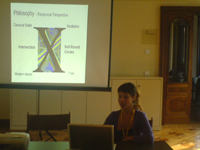East West Synthesis as a Training Model: Meditative Dance
Background
Meditative Dance originated in year 2000. Following two years of preliminary research, a body-mind development project was formed, taking its roots from East-West synthesis. The synthesis introduced by Meditative Dance is inspired by the artistic background of trainer and choreographer Sinan Temizalp. Sinan Temizalp started his professional gymnastics career at the age of 7. After receiving Classical Ballet education at State Conservatory, he headed towards contemporary dance techniques. His interest in Eastern techniques led him to a deep research in this field, extending from sufi mystics to shamans.
Thanks to his expertise in breathing techniques and his flexible body, Temizalp, together with his research team Quote, developed a training technique called Meditative Dance, with the aim of building a body with excellent movement abilities, which is flexible, healthy and strong at the same time. The techniques combine air (breath), ground (earth), water (fluidity) and people (contact).
“Meditative dance”, offers artistic development and artistic skills for people from different occupations, ages and backgrounds. Reflecting on the necessity of natural movement and artistic satisfaction for people from all ages and occupations in today’s world, Meditative Dance technique is designed to benefit people from all backgrounds. Hundreds of people attend to these lessons, workshops and seminars held in Istanbul, Turkey and in various countries of Europe, for health, artistic creativity, relaxation, development of balance, posture as well as capabilities of expression.
Meditative Dance – an Integral Approach


Meditative Dance formed its synthesis not through a sequential technical work, but by applying a natural combination of these techniques on human body. It made use of the basic forms in Classical Ballet for head, neck and posture; Yoga for the shoulders; Helen technique for the back and waist; and Modern Dance for enabling movement coordination. It achieved Balance in straight posture and spreading of body weight with the synthesis of Eastern and Western techniques. Eastern and Western techniques are integrated on human body in a perfect manner.
The picture of this integration is human body.
|
EAST |
CROSSROAD |
WEST
|
|
HATHA YOGA |
SUFI MYSTICS |
CLASSICAL BALLET |
|
MEDITATION |
ROUND CYCLES |
ALEXANDER TECHNIQUE |
|
|
|
POWER TECHNUQUE |
|
|
|
HELEN TECHNUQUE |
|
|
|
RISK TECHNUQUE |
Meditative dance takes its roots from sufis’ round cycles (movement meditation), their philosophy of continuous change and growth, fluid movement and approach to macro – micro cosmos in a translucent way.
Meditative dance seeks a systematic integration of body in a series of exercises, starting from ancient techniques and extending to most contemporary practices. In Meditative Dance lessons, which has been continuing for ten years, Health is the most important determinant.
In order to form a healthy body that does not produce illnesses, Meditative Dance structured a living, moving and straight body that breathes through all of its cells, vitalizes all of its muscles and is able to make use of all of its functions. The combination of Eastern and Western techniques helps to attain a unique balance and perfect posture. Breathe is the basic source that maintains and nurtures this straight pose. In our each and every breathe, we think of the spine, send our breathe to all around our body and maintain a straight posture.
Waist exercise continues in all the positions; on the ground, in the middle level and on air.
Reciprocal Perspective X – The Unknown
When our body moves, it takes a quite different shape than static positions. It may form unlimited combinations, but it must do those by achieving the right balance, with awareness and consciousness. Awareness in static positions is introduced by Yoga. Watching the nature, people experience the feeling of existence with Yoga in the East. In the West, the focus is on strength and realizing the potential of Human. Whereas, the Sufi mystics introduce movement meditation, searching after the movement of planets and the universe. In this manner, Sufi philosophy acts as a mediator between Human and the Nature. Western techniques of Classical Ballet and Modern dance represent the Human; while the Eastern techniques of Yoga and Meditation represent the Nature. In the intersection, the round cycles of Sufis represent the Earth (Body) moving in space.[1]
The right brain is “wired” to, and controls the left side of our body, while the left brain controls the right side. The existence of an intersection point becomes apparent with X – the Unknown. The unity of the right brain with the heart on our left side; and the unity of the left brain with the right hand, which is generally used for writing, are the secrets of the Unknown X in our body. And, the intersection point of Eastern and Western techniques is the Sufi circles.
The reciprocal perspective of our body enables it to be used as an exceptional method for stretching and elasticity. We can see this reciprocal perspective everywhere. Combination of Eastern and Western techniques makes it possible to use right and left hemispheres of the brain in an integrated way and in relation to each other.
Breathe, movement, gravity, and partnering (other people) are the life forces of this training; whereas the Western and Eastern techniques of ballet, power technique, contact improvization, risk, yoga and Sufi round cycles are its components. Breath and meditation exercise comes from the Eastern roots, whereas posture and muscle work reflects on Western disciplines such as ballet and contemporary dance techniques.
Holding no fears of the body and being able to use the body is only possible by getting to know it. To get to know our body, we can use various tools, and in this process we discover the gravity and its effect on our body. While we shape our body by spreading the weight, we can feed it with the breathe as well. We learn to protect our body through fluid movements and guard against all kinds of injuries.
